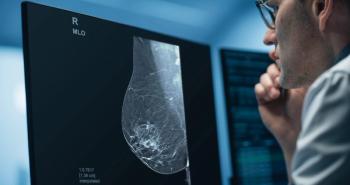
|Poll|November 14, 2013
Image IQ: 47-year-old with Irregular Mass in Dense Breast Tissue
Author(s)Stamatia Destounis, MD, FACR
Advertisement
A 47-year-old woman presents for screening mammography and requests a screening breast ultrasound. On mammography, no suspicious masses or areas of calcifications are identified. The breast tissue is extremely dense.
On ultrasound, there is a newly identified irregular hypoechoic mass in the left 2:00 area.
(Click on images to enlarge.)
What is your diagnosis?
Newsletter
Stay at the forefront of radiology with the Diagnostic Imaging newsletter, delivering the latest news, clinical insights, and imaging advancements for today’s radiologists.
Advertisement
Advertisement
Advertisement
Trending on Diagnostic Imaging
1
Assessing the Potential Impact in Radiology for GE HealthCare’s Acquisition of Intelerad
2
Sifting Through AI Predictions, Guesses, Hopes and Fears
3
Mammography Study: Can Slab Reconstruction Technology Reinvent Efficiency with DBT?
4
RSNA: CCTA Study Reveals Link Between Common Air Pollutants and Coronary Artery Stenosis
5




























